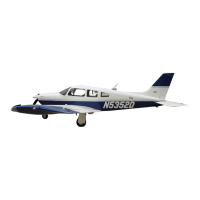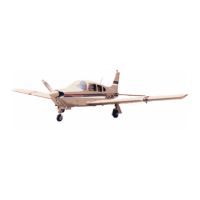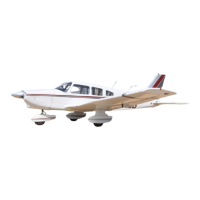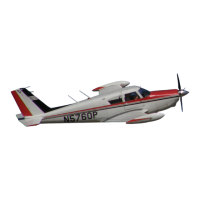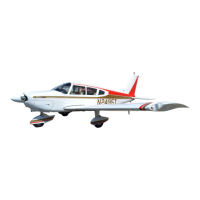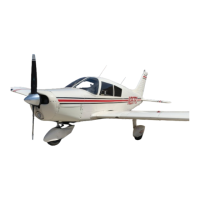D.C. GENERATION.
DESCRIPTION OF ALTERNATOR SYSTEM.
The PA-28RT-201 alternator is located on the front lower right side of the engine and utilizes a belt drive
from the engine crankshaft. The PA-28RT-201T alternator is mounted on the accessory case at the rear of the
engine. Many advantages both in operation and maintenance are derived from this system. The main advantage
is that full electrical power output is available regardless of engine RPM.
The alternator has no armature or commutator and only a small pair of carbon brushes, which make
contact with a pair of copper slip rings. The rotating member of the alternator, known as the rotor, is actually
the field windings. The rotor draws only 1/20th of the current output. Therefore, there is very little friction and
negligible wear and heat in this area. The alternating current is converted to direct current by diodes pressed
into the end bell housing of the alternator. The diodes are highly reliable solid-state devices, but are easily
damaged if current flow is reversed through them.
The alternator system does not require a reverse current relay, because of the high back resistance of the
diodes and the inability of the alternator to draw current or motorize. A current regulator is unnecessary
because the windings have been designed to limit the maximum current available. Therefore, the voltage
regulator is the only control needed.
An additional latching circuit is used to help keep the master solenoid closed when the battery voltage is
low and the engine starter is being operated. This circuit transfers voltage from the alternator to the master
solenoid coil, thus holding the master solenoid in the closed position and allowing the starter to function. This
circuit will also supply some voltage to the battery. A diode is placed into this circuit to prevent the reverse
flow of current from the battery to the alternator.
The circuit breaker panel contains a 5 ampere circuit breaker marked ALT FIELD. If the field circuit
breaker trips it will result in a complete shutdown of power from the generating system. After a one or two
minute cool-down period, the breaker can be reset manually. If tripping recurs and holding the breaker down
will not prevent continual tripping, then a short exists in the alternator field.
Unlike previous systems, the ammeter does not indicate battery discharge, but displays the load in amperes
placed on the generating system. With all electrical equipment off, except the master switch, the ammeter will
indicate the amount of charging current demanded by the battery. This amount will vary, depending on the
percentage of charge in the battery at the time. As the battery becomes charged, the amount of current
displayed on the ammeter will reduce to approximately two amperes. The amount of current shown on the
ammeter will tell immediately whether or not the alternator system is operating normally, if the following
principles are kept in mind.
—NOTE—
The amount of current shown on the ammeter is the load in
amperes that is demanded by the electrical system from the
a l t e r n a t o r. As a check, take for example a condition where the
battery is demanding 10 amperes charging current, then switch
on the landing light. Note the value in amperes placarded on the
panel for the landing light fuse (10 amperes) and multiply this by
80 percent, you will arrive at a current of 8 amperes. This is the
approximate current drawn by the light. Therefore, when the
light is switched on, there will be an increase of current from 10
to 18 amperes displayed on the ammeter. As each unit of
electrical equipment is switched on, the currents will add up and
the total, including the battery, will appear on the ammeter.
24-31-00
Page 24-11
Revised: August 17, 1982
1I6
PIPER AIRCRAFT
PA-28RT-201 / 201T
MAINTENANCE MANUAL

